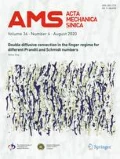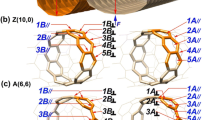Abstract
Coupled effects of mechanical and electronic behavior in single walled carbon nanotubes are investigated by using quantum mechanics and quantum molecular dynamics. It is found that external applied electric fields can cause charge polarization and significant geometric deformation in metallic and semi-metallic carbon nanotubes. The electric induced axial tension ratio can be up to 10% in the armchair tube and 8.5% in the zigzag tube. Pure external applied load has little effect on charge distribution, but indeed influences the energy gap. Tensile load leads to a narrower energy gap and compressive load increases the gap. When the CNT is tensioned under an external electric field, the effect of mechanical load on the electronic structures of the CNT becomes significant, and the applied electric field may reduce the critical mechanical tension load remarkably. Size effects are also discussed.
Similar content being viewed by others
References
Cheng HM. Carbon Nanotubes Synthesis, Microstructure, Properties and Application. Beijing: Chem Tech Publisher, 2002, 203–332
Ruoff RS, Lorents DC. Mechanical and thermal properties of carbon nanotubes.Carbon, 1995, 33:925–930
Treacy MM, Ebbesen TW, Gibson JM. Exceptionally high Young's modulus observed for individual carbon nanotubes.Nature, 1996, 381:678–680
Falvo MR et al. Bending and buckling of carbon nanotubes under large strain.Nature, 1997, 389:582–584
Wong E, Sheehan P, Lieber C. Nanobeam mechanics: elasticity, strength, and toughness of nanorods and nanotubes.Science, 1997, 277:1971–1975
Yao N, Lordi V. Young's modulus of single-walled carbon nanotubes.J Appl Phys, 1998, 84:1939–1943
Yakobson BI, Campbell MP, Brabec CJ, et al. High strain rate fracture and C-chain unraveling in carbon nanotubes.Comput Mater Sci, 1997, 8:341–348
Yu MF, Lourie O. Strength and breaking mechanism of multiwalled carbon nanotubes under tensile load.Science, 2000, 287:637–640
Lourie O, Cox DM, Wagner HD. Buckling and collapse of embedded carbon nanotubes.Phys Rev Lett, 1998, 81:1638–1641
Wagner HD, Lourie O, Feldman Y, et al. Stress-induced fragmentation of multiwall carbon nanotubes in a polymer matrix.Appl Phys Lett, 1998, 72: 188–190
Andrews R et al. Nanotube composite carbon fibers.Appl Phys Lett, 1999, 75:1329–1331
Dai H, Wong EW, Lieber CM. Probing electrical transport in nanomaterials: conductivity of individual carbon nanotubes.Science, 1996, 272:523–526
Fischer JE et al. Metallic resistivity in crystalline ropes of single-wall carbon nanotubes.Phys Rev B, 1997, 55:R4921-R4924
Tans SJ, Verschueren ARM, Dekker C. Room-temperature transistor based on a single carbon nanotube.Nature, 1998, 393:49–52
Martel R, Schmidt T, Shea HR, et al. Single- and multi-wall carbon nanotube field-effect transistors.Appl Phys Lett, 1998, 73:2447–2449
Chico L, Crespi VH, Benedict LX, et al. Pure carbon nanoscale devices: nanotube heterojunctions.Phys Rev Lett, 1996, 76:971–974
Postma HWC, Teepen T, Yao Z, et al. Carbon nanotube single-electron transistors at room temperature.Science, 2001, 293:76–79
Rueckes T, Kim K, Joselevich E. Carbon nanotube-based nonvolatile random access memory for molecular computing.Science, 2000, 289:94–97
Collins PG, Arnold MS, Avouris PH. Engineering carbon nanotubes and nanotube circuits using electrical breakdown.Science, 2001, 292:706–709
Collins PG, Arnold M, Hersam M, et al. Current saturation and electrical breakdown in multiwalled carbon nanotubes.Phys Rev Lett, 2001, 86:3128–3131
De Heer WA, Chatelain A, Ugarte D. Aligned nanotube films: production and optical and electronic properties.Science, 1995, 268:845–847
Rinzler AG, et al. Unraveling nanotubes-field-emission from an atomic wire.Science, 1995, 269: 1550–1553
Zhou G, Duan WH, Gu BL. Electronic structure and field-emission characteristics of open-ended single-walled carbon nanotubes.Phys Rev Lett, 2001, 87:095504–095507
Wang ZL, Gao RP, Poncharal P, et al. Mechanical and electrostatic properties of carbon nanotubes and nanowires.Materials Science and Engineering C, 2001, 16:3–10
Hansson A, Paulsson M, Stafstroml S. Effect of bending and vacancies on the conductance of carbon nanotubes.Phys Rev B, 2000, 62:7639–7644
Tekleab D, Carroll DL, Samsonidze GG, et al. Strain-induced electronic property heterogeneity of a carbon nanotube.Phys Rev B, 2001, 64:035419–035424
Kim C, Kim B. Effect of electric field on the electronic structures of carbon nanotubes.Appl Phys Lett, 2001, 79:1187–1189
Leach AR. Molecular Modelling. London: Addison Wesley Longman Limited, 1996. 54–79
Stewart JJR. Optimization of parameters for semi-empirical method I. Method.J Comput Chem, 1989 10:209–220
Stewart JJR. Optimization of parameters for semi-empirical method II. Applications.J Comput Chem, 1989, 10:221–264
Author information
Authors and Affiliations
Additional information
The project supported by the National Natural Science Foundation of China (10372044) and the Cheung Kong Scholars Programme
Rights and permissions
About this article
Cite this article
Wanlin, G., Yufeng, G. The coupled effects of mechanical deformation and electronic properties in carbon nanotubes. Acta Mech Sin 20, 192–198 (2004). https://doi.org/10.1007/BF02484265
Received:
Issue Date:
DOI: https://doi.org/10.1007/BF02484265




